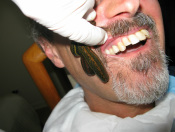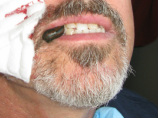Root Canal, Tooth decay, Gum Disease and HIRUDOTHERAPY

The first type is an infection inside your tooth, in the living pulp tissue.
This comes from tooth decay or severe irritation. Ordinarily, when bacteria grow in your
body, your body responds by sending antibodies and white blood cells to fight
the bacteria. Because of this body response, the tissue will swell. For minor
infections, the antibodies and white blood cells may completely eliminate them,
without the outside help of antibiotics. However, inside your tooth, this
natural defense mechanism breaks down because there is no room for antibodies
and white blood cells. And antibiotics are of no help here either. Therefore,
when your tooth becomes infected, it will not recover, and the pulp tissue will
die. The treatment for this condition is a root canal treatment. With a root canal, the soft
tissue inside your tooth is removed and replaced with a sealer material that
keeps infection from seeping back into the tooth.
There is a second type of tooth infection which occurs in the bone around the
end of the tooth. You will get what is called a tooth abscess. An abscess may or may not be painful.
When bacteria are in the bone, your body can fight them with antibodies and
white blood cells. The problem is that there is a constant supply of new
bacteria to the region from the dead tissue inside your tooth. Your body may or
may not be successful in walling off the infected area, so an abscess can go on
for years without hurting. But the risk of damage is great. The abscess can grow
and spread, and it can even cause the root of your tooth to be gradually
dissolved. Treatment, again, would be a root canal procedure.
In the case of a failed root canal, you will also have an abscess
forming. Treatment in this case would be retreatment or root canal surgery.
The third type is a gum infection. This occurs in the gum tissue. Again,
your body can fight this. It can also result in an abscess.
There are many grades and types of gum infections, and there are specialists called periodontists that are trained
exclusively in treating the gums.
The most common medical treatment for gum disease is antibiotics to treat the infection caused by the bacteria. To decrease the inflammation and swelling anti-inflammatory medication is also prescribed.
HOWEVER IT DOEAS NOT RESOLVE THE PROBLEM! IT IS ONLY A TEMPORARY FIX!
Leech Therapy for Decay & Pulp Tissue Restoration
SGS - Salivary Glands Secretion in leeches are known to produce many beneficial enzymes and have been used for many years to treat effectively and promote healing of various diseases, among them are gum diseases. Anticoagulation agents increase blood flow in the gums, helping to eliminate toxins and allow delivery of nutrients to the affected area. These anti-coagulation agents also dissolve the blood clots that could be developed in the gums.
The saliva in leech also contains antibacterial components that assist in reducing bacterial growth.
During applied hirudotherapy the bacteria is eliminated and the plaque is removed.
Root Canal? Myths & misconceptions about it.

What is "having a root canal"?
Root canal treatment with hirudotherapy, despite all of the misleading myths and misconseptions spread about it, does, in fact, provide an invaluable service.
It allows to prove that severely damaged teeth can be saved.
We know that ordinary dental process is to PERFORM TRADITIONAL ROOT CANAL, TO CONTINUE POST-DENTAL WORK, SUCH AS CROWN PLACEMENT, BRIDGES, etc., etc. We know why traditional dental work many times fails, how much treatment costs, and whether our stomathologist strongly sugests that a dental implant could be a better choice!
What is root canal treatment?
Root canal therapy refers to the process where a dentist treats the interior aspects of a tooth, specifically, that space occupied by its "pulp tissue." Most people would probably refer to a tooth's pulp tissue as its "nerve," however, doing so is only partially accurate. While pulp tissue does contain nerve fibers, it is also composed of arteries, veins, lymph vessels, and connective tissue.
People seem to be most familiar with the terms nerve, nerve tissue, but a pulp tissue refers to the same thing.
Where precisely in a tooth is its nerve? Teeth are not solid objects. Inside every tooth there lies a hollow space that contains its nerve tissue. Dentists use the following terms to refer to various portions of this nerve space:
A) The pulp chamber. This is the hollow area that lies, more or less, in the center of the tooth's crown (that part of the tooth positioned above its gum line).
B) The root canals. A tooth's root canals run from the apex (tip) of its root up to its pulp chamber. The layout of the nerve space inside different types of teeth is quite different. Teeth always have just one pulp chamber but the number of individual root canals that they have can vary widely.
Every tooth will have at least one root, and some have 2, 3 or possibly more. Each tooth root will have at least one root canal. The roots of some teeth, however, are well known for frequently having 2 or more canals.
- The COST OF ROOT CANAL TREATMENT in general dental practice is typically based on the number of individual canals that are treated. The greater the number, the higher the cost.
- Treatment time is affected by the number of canals being treated. It is more time consuming for a dentist to treat a tooth with 4 canals as opposed to one just having a single canal.
- Many times up to $900 per ONE CANAL!
THE BENEFITS TO USE HIRUDOTHERAPY TREATMENTS INSTEAD:
- Your pulp tissue will be restored-
And, what comes along, there are some other functions that the nerve performs, not that you would ever know it!.
Early on, a tooth's nerve tissue plays an important role in the formation and development of the tooth. Then, once it has formed, the function of this nerve, pulp tissue tissue, becomes one of helping to preserve the tooth's health and vitality.
- Your tooth will still be "alive"-
The nerve tissue helps to keep the organic components of the tooth's mineralized tissues (dentin and enamel) supplied with nutrients and moisture. It also produces new tooth structure (reparative dentin) as is needed to help to wall off and protect the nerve from insult or injury (such as advancing tooth decay).
- Your treatment will cost you not more than $300 with hirudotherapy;
All natural, without novocaine shots, without any post-medications, pain killers, surgery etc.!

